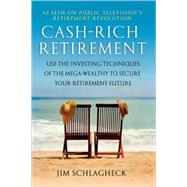
Note: Supplemental materials are not guaranteed with Rental or Used book purchases.
Purchase Benefits
What is included with this book?
JIM SCHLAGHECK is an author, banker, longtime advisor to the ultrawealthy, and the coproducer of the public television series Retirement Revolution. He has written numerous articles on investing, retirement, and finance, and is also an acclaimed speaker, who describes better ways for retirement readiness to audiences of wealth management professionals and lay investors nationwide.
| Acknowledgments | p. v |
| Preface | p. vii |
| Introduction: A Call to Arms! | p. 1 |
| Your Retirement Is in Grave Danger! | |
| Is Retirement a Dying Experiment? | p. 11 |
| Your Core Investment Beliefs Are Wrong-Dead Wrong! | p. 28 |
| The Coming Demographic Storm | p. 36 |
| Six Steps to Bulletproof Your Retirement | |
| Change Your "Automatic Pilot" | p. 60 |
| Diversify Your Holdings in Radically Different Ways | p. 80 |
| Build Out Your Investment Plan with Funds, Indexes, and Objective Research | p. 105 |
| Get All the Professional Help You Can! | p. 130 |
| Build Income Streams with a Ladder of Annuities | p. 142 |
| Invest in Health Care Insurance | p. 172 |
| The Care and Feeding of Your Nest Egg | |
| The Importance of Periodic Tune-ups | p. 199 |
| Tapping Your Home for Retirement Income | p. 208 |
| When to Get Defensive | p. 227 |
| Conclusions | p. 246 |
| Notes | p. 253 |
| Index | p. 273 |
| Table of Contents provided by Ingram. All Rights Reserved. |
The New copy of this book will include any supplemental materials advertised. Please check the title of the book to determine if it should include any access cards, study guides, lab manuals, CDs, etc.
The Used, Rental and eBook copies of this book are not guaranteed to include any supplemental materials. Typically, only the book itself is included. This is true even if the title states it includes any access cards, study guides, lab manuals, CDs, etc.